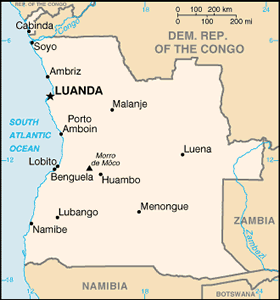The Geography of Angola
The Geography of Angola
Angolan Geography
Location: Southern Africa, bordering the South Atlantic Ocean, between Namibia and Democratic Republic of the Congo
Geographic coordinates: 12 30 S, 18 30 E
Map references: Africa
Area: total: 1,246,700 sq km land: 1,246,700 sq km water: 0 sq km
Area - comparative: slightly less than twice the size of Texas
Land boundaries: total: 5,198 km border countries: Democratic Republic of the Congo 2,511 km (of which 225 km is the boundary of discontiguous Cabinda Province), Republic of the Congo 201 km, Namibia 1,376 km, Zambia 1,110 km
Coastline: 1,600 km
Maritime claims: territorial sea: 12 nm contiguous zone: 24 nm exclusive economic zone: 200 nm
Climate: semiarid in south and along coast to Luanda; north has cool, dry season (May to October) and hot, rainy season (November to April)
Terrain: narrow coastal plain rises abruptly to vast interior plateau
Elevation extremes: lowest point: Atlantic Ocean 0 m highest point: Morro de Moco 2,620 m
Natural resources: petroleum, diamonds, iron ore, phosphates, copper, feldspar, gold, bauxite, uranium
Land use: arable land: 2.65% permanent crops: 0.23% other: 97.12% (2005)
Irrigated land: 800 sq km (2003)
Natural hazards: locally heavy rainfall causes periodic flooding on the plateau
Environment - current issues: overuse of pastures and subsequent soil erosion attributable to population pressures; desertification; deforestation of tropical rain forest, in response to both international demand for tropical timber and to domestic use as fuel, resulting in loss of biodiversity; soil erosion contributing to water pollution and siltation of rivers and dams; inadequate supplies of potable water
Environment - international agreements: party to: Biodiversity, Climate Change, Climate Change-Kyoto Protocol, Desertification, Law of the Sea, Marine Dumping, Ozone Layer Protection, Ship Pollution signed, but not ratified: none of the selected agreements
Geography - note: the province of Cabinda is an exclave, separated from the rest of the country by the Democratic Republic of the Congo


